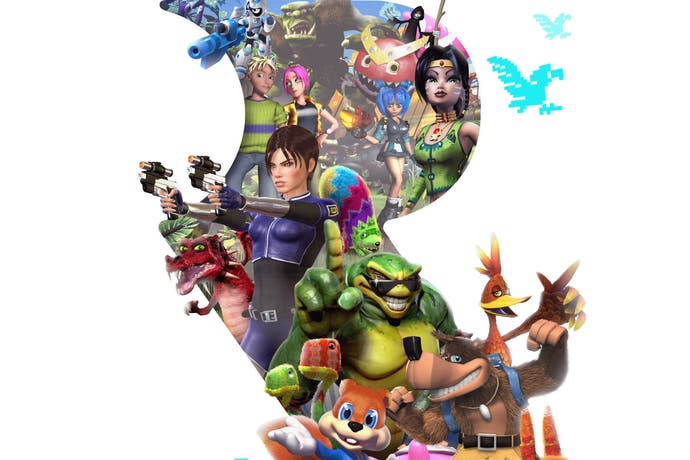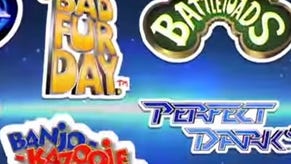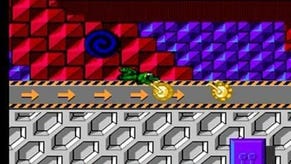Digital Foundry vs Rare Replay
The highs and the lows of Xbox One back-compat, the Grabbed by the Ghoulies 1080p60 remaster - and more.
In our first look at Rare Replay, we concentrated on the firm's classic N64 titles, noting that the firm had utilised two different approaches to emulation in bringing its classic catalogue onto Xbox One. Where Xbox 360 remasters were available, Xbox One's shiny new backwards compatibility functionality was utilised to excellent effect, while the rest of the titles employed direct emulation of the original consoles, with no actual remaking or remastering in play - though the 1080p resolution boost was clearly worthwhile.
Taking a look across the rest of the package, we see emulation is also employed to bring almost every game in the line-up onto Xbox One - with one glorious exception. Rare's Microsoft debut - Grabbed by the Ghoulies - is treated to an Xbox One-specific 1080p60 conversion, seemingly ported over from the original source - and we'll be covering that later. But for the bulk of this article, it's the Xbox 360 line-up that gets the lion's share of our attention, offering up another opportunity to examine the technological credentials of Microsoft's remarkable virtual machine.
In our previous look at Xbox One back-compat, we found that some titles actually performed better on the system compared to the same game running on 360 (Perfect Dark Zero a case in point) while others showed a mixture of no improvements at all, or an actual decrease in performance. One curious element of the virtual machine is its seeming inability to support adaptive v-sync - on the plus side, this means that there's no screen-tear on Xbox One, but on the flip-side, this is almost certainly contributing to the issues surrounding games where performance doesn't compare well with the Xbox 360 originals.
In the case of Rare Replay, it's mostly good news in terms of virtual machine performance. With Kameo, Xbox One manages to run the game a little more smoothly than its predecessor. While similar frame-rates are present across both platforms, the appearance of tearing produces more noticeable judder on 360, whereas the increased level of image consistency on Xbox One helps to create more fluid motion where performance is otherwise on par. For the most part we only see Xbox One visibly stutter in areas when the engine initially switches from gameplay to real-time cut-scenes, or after the achievement unlocked icon appears on screen - scenarios where Xbox 360 has no real problems. Otherwise, the bottom line is that Kameo shows the Xbox 360 virtual machine operating at its best; inching ahead of the performance level set by Microsoft's vintage 2005 console, with improved image integrity.
The experience with Viva Piñata is a little more interesting. The core gameplay operates at 30fps, although tearing and small frame-rate drops are common on Xbox 360. The slower paced nature of the game ensures that performance remains smooth for the most part, with frame-rate hitches and tearing only noticeable when quickly panning the camera around the environment.
Again, the Xbox One virtual machine performs extremely well here. Rare Replay offers up a smoother experience with fewer frame-rate drops and no tearing whatsoever. However, curiously, cut-scenes that are v-synced and capped at 30fps on 360 are unlocked on Xbox One: frame-rates generally reach up into the high forties delivering a visible jump in smoothness, but not without judder. As it is, Xbox 360 often fails to hit a solid 30fps in the more demanding of these sequences. However, elsewhere we actually find segments that operate at a solid 60fps with v-sync enabled on the 360, with the console featuring a clear advantage over Xbox One. The back-compat virtual machine hands in metrics that hover around the 48fps mark, revealing that perhaps the emulation isn't capable of running at full speed in areas where frame-rates are essentially uncapped.
However, back-compat performance in Rare Replay isn't completely without its issues. Banjo Kazooie: Nuts and Bolts is a much later Xbox 360 release, clearly more demanding on the hardware. While Rare tones down the extravagant use of parallax occlusion mapping used in Perfect Dark Zero and Kameo, detail levels and draw distances remain high, and vehicular physics are added alongside the third-person platforming mechanics. On Xbox 360, the game regularly hits the intended 30fps target, but does tend to drop a few frames and introduce pockets of tearing when driving through more effects-heavy segments of the game, such as the first night-time race against Grunty. Performance around the game's hub world is pretty stable, with the engine clearly capable of handling complex environments with ease.
Xbox One generally has a more difficult time in achieving the same level of performance, with the demanding nature of the game making it more difficult to emulate smoothly compared to the earlier titles. The lack of tearing is a clear bonus, but in detailed areas, frame-rates are often hit hard, dropping down to 20fps for extended periods. An opening ride to the top of a mountain in Showdown Town is a prime example, where long draw distances and detailed scenery appear to be the cause. While the game remains enjoyable across a general run of play, the experience doesn't feel quite as responsive or polished compared to its original Xbox 360 debut.
Despite the excellent showing of the virtual machine elsewhere within Rare Replay, the performance of Nuts and Bolts suggests that while technologically impressive, backwards compatibility still has a long way to go - we're looking forward to testing the quartet of Gears of Wars titles opening up soon on Xbox One with the release of the Ultimate Edition later on in the month.
While the vast majority of titles are deployed via emulation in Rare Replay, Grabbed by the Ghoulies is directly ported over to the Xbox One hardware, re-coded to take advantage of the higher spec and delivering clear upgrades over the classic Xbox version. Originally running at 480p30, on Xbox One we are given a full-fat 1080p presentation running at twice the frame-rate. Unlike the other 3D games in the package, there's no anti-aliasing in play, but despite this, jaggies aren't really a problem, with the lack of sub-pixel detail helping to provide a smooth but sharp look to the game.
Performance-wise, frame-rates stick closely to the desired 60fps mark with very little in the way of noticeable interruptions to distract us away from gameplay. The only impact we see to fluidity comes in the form of occasional pauses where the simulation appears to stall. During these moments the engine temporarily drops v-sync and renders out frames with some light tearing. These are only minor blips and have little impact on how well the game plays: attacks using the left analogue stick feel more responsive with the doubling of frame-rate, while the added smoothness delivers a silky arcade quality feel to the presentation that simply wasn't there before.
The care and attention that has gone into porting over a relatively unloved classic Xbox game is unexpected, but it's also a very welcome surprise - after all, Rare Replay now offers an experience superior to the original game. We are essentially looking at an Xbox One remaster here, and although core art assets show little signs of improvement, they hold up very well despite the massive jump in resolution. The results are excellent and we would have liked to see Conker: Live and Reloaded given the same treatment. Unfortunately, Rare's classic Xbox remake of Conker's Bad Fur Day is completely absent, which is a shame as this version is vastly superior to the original N64 title, featuring better controls and camera, along with reworked environments and brand new content. Having this available at 1080p60 in would have been a real treat for fans, while giving the collection a sense of completion it currently seems to lack.
For many, Rare's 3D titles are the focal point of the collection, but there's also a host of classic 2D games included too, ranging from early ZX Spectrum hits where the developer first made its mark to popular NES titles and arcade games. Not every major 2D game is included in the collection - Killer Instinct and its sequel are absent, and of course Nintendo-licensed titles are obviously excluded - but the bulk of the studio's most popular work makes it here intact. All of the games are displayed in their original 4:3 aspect ratios, upscaled to 1080p for display on modern TVs - it's not possible to render hand-drawn low resolution sprites in HD, so resizing the image is the only way to make these titles fill the screen. Naturally, Spectrum games can now be launched without needing a keyboard, while the NES controls are sensibly mapped to the Xbox One gamepad.
Rare Replay provides two distinct options for displaying 240p games in HD, switched during gameplay by clicking down on the right analogue stick. A straightforward 'nearest neighbour' upscale provides a clean, albeit blocky image without blurring or other traditional scaling artefacts, while a CRT mode attempts to recreate how these titles appeared on a traditional tube television or arcade monitor. The latter delivers a more authentic 240p look to these games, although the effect is overdone, resulting in a blurry image with far too much curvature and contrast. In that respect we preferred the sharper images produced by the basic pixelated upscale but we feel that offering up a third preset using scan-lines and a simple aperture grill filter would have provided a nice compromise between the two extremes currently on offer.
Despite the lack of display options, the 2D titles in the collection are otherwise faithfully emulated, with flicker appearing at similar moments in RC Pro Am on the NES or Jetpac on the ZX Spectrum when the original hardware was pushed in directions it didn't really want to go. Slow-down also occurs at similar moments, vouching for the authenticity of the emulation. Curiously, there are some differences with Rare's early Spectrum games though: in Rare Replay, Jetpac uses the Lunar Jetman's character set, while SabreWulf adopts the font originally used in Underwurlde.
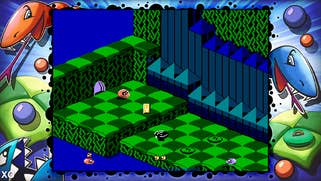
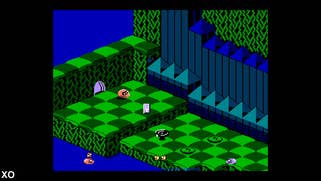
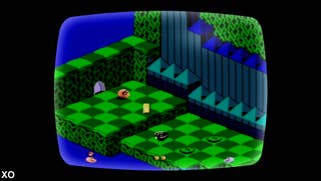

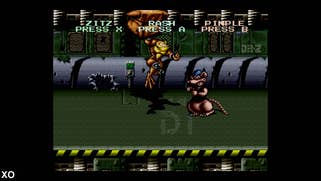





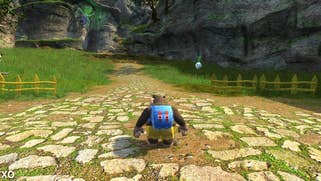
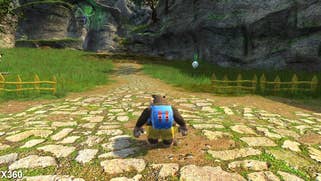

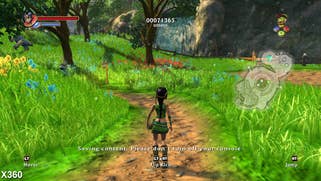
Away from the variable nature of each title's technical implementation, it's clear that Rare has put a lot of effort into this collection in other areas. In particular, the menus for pre-1996 titles includes options to use cheats or activate dip switches in arcade games, allowing for infinite lives, for example. It's also possible to rewind progress via the left trigger, allowing for an easier learning curve for newcomers who may find some of Rare's early games a little too difficult. Another nice touch is the ability to unlock behind the scenes videos and other extras as you play through each title in the collection. One of the coolest secrets is a video showcasing concept art and footage from the cancelled sequel to Kameo.
Rare Replay's prolific use of emulation has some downsides, and one of those is the variable conversion quality of each game in the collection. However, the majority of the Xbox 360 titles gain a welcome performance upgrade on Xbox One, though the poorer frame-rate in Banjo Kazooie: Nuts and Bolts is a bit of a disappointment and tangibly impacts the experience. From a technical perspective, the N64 titles often provide a better experience than the original titles, despite the very different approaches to emulation employed. Elsewhere, while we may have some gripes about the presentation, the older 2D games are as authentic as you would hope.
In the final analysis, we've had a great time re-acquainting ourselves with Rare's prolific back catalogue - 30 games for just £20 is supreme value, and despite the fact that this is a retro collection based on mostly untouched emulated oldies, the technological story behind Rare Replay is fascinating. On top of that, there's talk of additional Rare titles appearing via DLC, so maybe that Xbox One port of Conker: Live and Reloaded isn't so far away - but even as is, Rare Replay is a lovely collection that comes highly recommended.
